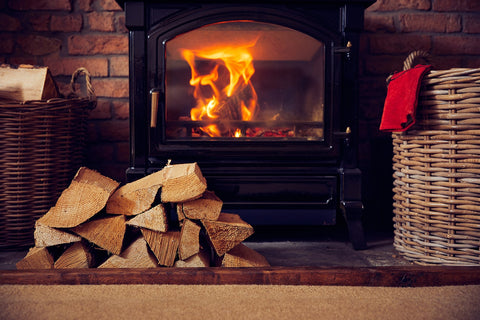What is Wet Wood (And Why You Shouldn't Buy It)
The world of woodburning is a difficult one to navigate, but at some point throughout your research, I'm sure you've heard some negative comments about wet wood with others emphasising the importance of burning dry wood. With this in mind, you may be asking the question, what is wet wood? And more importantly, why should I avoid it? We discuss the topic in our blog.
What is wet wood?
The answer is straightforward. Wet wood is, quite simply, wood that has a high moisture content- any logs higher than 20% moisture content to be precise.
Wet wood doesn't necessarilty have to feel damp to the touch because it actually refers to the moisture content within the wood. Typically when timber is harvested, the moisture content is above 60%, meaning that more than half the weight of the wood is actually moisture rather than wood fibre. With the Ready to Burn Scheme, firewood must be reduced to below 20% to be sold legally.

What are the problems with burning wet wood?
Now we understand what wet wood actually is, let's take a look at why it should be avoided.
Decreased Efficiency
Any firewood with a high moisture content takes longer to catch fire, or in some cases, will struggle to catch fire at all.
The kiln drying process removes most of the moisture from the log and, most importantly, from the core of the log. When firewood is burnt, it gives off volatile gases. It is these volatiles that ignite to give out the real heat.
If wood has too much moisture, all the energy goes to burning off the water and just doesn’t get to the point of producing heat until much later in the process.
As well as the poor heat output, if you burn wet wood, you will fall victim to high amounts of smoke, and nobody wants that in their living room.

Harmful to the Envionment
Wood above 20% moisture content produces more smoke and harmful by-products, which pollute the air. We would always reccomend purchasing kiln dried logs as the process of kiln drying burns off sap and excess water, resulting in a more effiecient and environmentally-friendly burn.

PM 2.5 Exposure
The pollutants emmited by wet wood are not only bad for the environment, but also for human health. It is common knowledge that high levels of exposure to PM 2.5 can have serious health implications.
When discussing this topic, wood fuel should not be the only focus. In this day and age, the PM 2.5 emmissions rely heavily on the appliance type.
Using independent research carried out last year for the SIA by Mitchell and Cottam the report calculates that the breakdown of emissions between appliances can be shown as follows:
|
Appliance Type |
Emissions (‘000 tonnes) |
% of total from domestic combustion |
Domestic combustion as % of overall UK total PM2.5 emissions from all sources |
|
Ecodesign stoves |
1.11 |
4.88% |
1.3% |
|
Older stoves |
5.17 |
22.76% |
6.3% |
|
Open fires |
16.43 |
72.36% |
19.8% |
Damages the Stove
Wet wood can cause damage to your wood burner. If your stove has a glass front, the resisdue that's left from the wet wood can gause the glass to blacken. Not only is this annoying to clean, but it will mean you will have to take time out maintain your stove more than if you were to burn fuel below 20% moisture content.
This same residue will stick to, and remain inside of, your chimney, potentially causing corrosive damage. This is very dangerous and can lead to a chimney fire.

What type of wood should I be burning?
By putting the above in black and white, you can clearly see the harmful effects burning wet wood has on the environment, your stove's performance and your health.
So, the question is, what fuel should you be using? The answer is "clean fuels" such as kiln dried logs which have been dried below 20% moisture content. If you choose a Ready to Burn approved supplier, you will be guaranteed to be purchasing wood that is below 20% moisture.
In the picture below, we trialed the burning of wet logs vs kiln dried logs. The difference is apparent as on the left you have a chiminea which has been lit using wet logs and on the right you have a lit chimenea which used kiln dried logs. The chimenea using wet logs struggled to light and produced excess smoke.

All Certainly Wood firewood has been sourced from sustainably-managed forests from within a 150-mile radius of our base of Hereford. Our kiln dried logs have been dried out to provide an optimal low moisture content, which is always below 20%.
You can purchase our kiln dried logs in a variety of formats and sizes. Shop now.


Comments